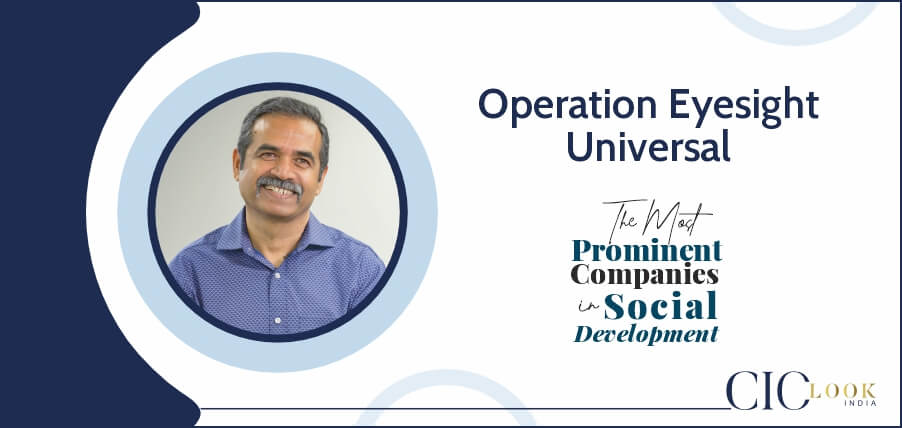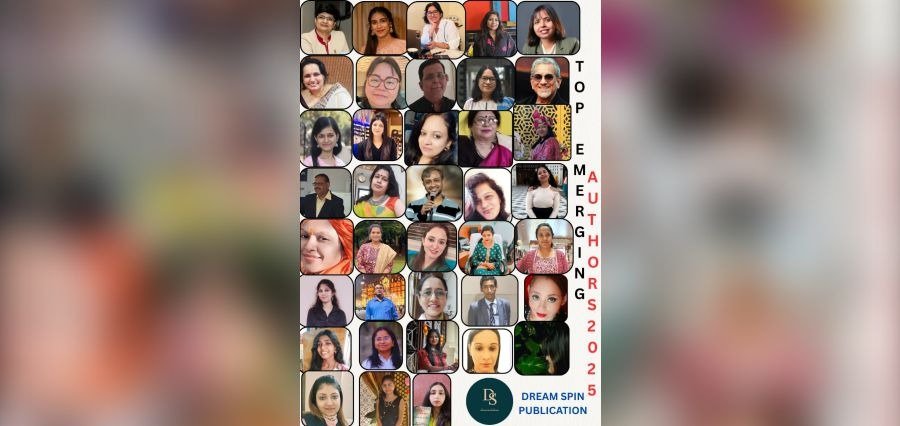What marvelously profound sensory organs human eyes are. Considered one of the most essential, significant, and complexly sophisticated visual mechanisms, the eyes help us see the world externally and within our own selves with the help of the mind’s eye.
However, due to old age, or other factors, eyes get decayed, injured, or unhealthy, resulting in vision loss, impairment, or blindness. Treating eyes in the best possible healthcare system does not have to be too costly for those who need it most urgently.
It is time for affordable eye healthcare for all. Believing in this noble cause, Operation Eyesight Universal, an international development organization based in Calgary, Canada, partners with communities to make quality and affordable eye health care available to those who need it most.
Ending Blindness
Kashinath Bhoosnurmath, President and CEO, shares, “We currently have programs in South Asia and sub-Saharan Africa and are focused on empowering communities to look after their own eye health. We do this by addressing the root causes of avoidable blindness, including poverty, gender inequality and access to fresh water.”
Healthy eyes are a key part of the whole person’s health, and in India, Operation Eyesight focuses on integrating eye health care with the country’s primary health care system. Operation Eyesight is one of the few development organizations in the country that has established partnerships with the government. Kashinath informs, “When it comes to eye care, we work on both sides of the supply-demand equation, with ‘supply’ being the health care services and resources available to a community, and ‘demand’ being the need and desire for those services within a community itself.”
Capacity Building for Communities and Local Care Providers
He furthers that they are focused on building the capacities of partner hospitals and supporting them in delivering quality eye health care, regardless of a patient’s ability to pay. “We also work alongside communities surrounding our partner hospitals and leverage their unique strengths to take ownership over their own eye health,” add Kashinath. As health awareness and education increase, so does the community’s demand for health services. The net impact of partnering with hospitals and communities is that the organization is eliminating avoidable vision loss on a sustainable basis.
In communities, Operation Eyesight brings eye health screening, prescription eyeglasses and specialist referrals, to people’s doorsteps, by establishing local Vision Centres. As well as recruiting and training local community health workers who conduct door-to-door eye health screening and referral. This ensures no one is left behind, particularly women and girls, who face many systemic and cultural barriers to accessing eye health care. These local health workers also provide health education on a variety of topics within their own communities.
A Globally Vocal Visionary
Kashinath has worked with Operation Eyesight for 14 years. He has more than 30 years of progressive experience providing strategic leadership, policy and programme directions, fund development, change and crisis management, partnership development, advocacy and external representation.
He enjoys a 360-degree understanding of the development and eye health sectors at a community, regional, national and international level. Kashinath spearheaded their flagship approach, Hospital-Based Community Eye Health, and as a result, helped increase their countries of work from four to eight and expanded the scope of their eye health projects.
As President & CEO of Operation Eyesight, Kashinath sees eye health care as part of whole-person health, which informs the organization’s focus on partnership and has helped make it a trusted partner of institutions and governments.
Kashinath also serves on the International Agency for the Prevention of Blindness (IAPB) Board of Trustees and was recognized as an Eye Health Leader by IAPB in 2013.
Techno-Aided Revelation
Being an experienced leader, Kashinath opines how adopting modern digital technologies impacts the social reform sector. He says that digital technology and eHealth are changing the face of global health in the following ways:
- Telemedicine technology is increasingly becoming the standard of care across the health sector, empowering clinicians to reach patients without being encumbered by limitations of time and geography. “This allows us to bring high-quality health services to people living in remote areas.”
- Virtual care is bringing eye health care and physician consultation to rural and remote areas, addressing a major gap in trained human resources cost-effectively.
- Technological advances are bringing improved quality of diagnosis and treatment. “For example, in Kenya, we have partnered with Peek Vision, an innovative app developer that supports eye health screening in schools, through a ‘train the trainer’ approach.”
- Advances in technology are also facilitating up-to-date information sharing so patients and families can benefit from the latest developments in diagnostic and treatment protocols. He cites, “For example, in India, we have partnered with L V Prasad Eye Institute to implement eyeSmart, a digital application that supports both telemedicine and secure data sharing via electronic health records.”
Breaking the Eye-Health Challenges
According to Kashinath, considering the current scenario, there are several challenges in providing affordable eye healthcare to the masses. The international development landscape continues to evolve due to cultural, geopolitical and climate issues – the list goes on. Now more than ever, eye health cannot be seen in isolation; it is connected with various issues, including poverty, education, equality for women and girls, fresh water and access to health care. The United Nations Sustainable Development Goals (SDGs) also recognize that these issues – and their solutions – are interrelated. Collaboration and partnership between agencies and across sectors are critical when it comes to addressing the determinants of health as they relate to eye health and creating a more just and equitable world. This includes partnering with governments and other institutions.
Accessibility, affordability and local availability remain key barriers to many patients and families who need eye health care in India. Kashinath states, “That is why our key activities include training local health workers to conduct eye health screening and health education in the community, as well as establishing local vision centres. Our school’s eye health programs enable us to reach many children in the community with eye health screening and specialist referrals if needed.
Funding projects and programmes is an ongoing challenge for most non-profits, which we address through a two-pronged approach. It includes partnerships with existing hospitals which bear 50% of project costs. It also helps integrate eye health care within existing health systems. We are also pursuing a fundraising strategy in India and partnering with generous donors in-country.
Eye health continues to be an evolving area, and we have started to see evolving health trends such as increased cases of Retinopathy of Prematurity due to increased survival rates of premature infants. We are partnering with more specialists and more centres of excellence to address these emerging trends.”
Fostering Accessible & Affordable Eye-Healthcare
Kashinath believes that social development initiatives and policies must form the basis of growth and development for the well-rounded and holistic development of any country or society. Eye health is no exception.
When it comes to eye health, many countries worldwide still do not have adequately developed eye health strategies. This leaves affordable and accessible eye health care out of reach for many people.
Leaders are beginning to recognize that development issues are interconnected. For example, healthy eyes and access to affordable vision care play a key role in a parent’s ability to earn an income and provide for their family, a child’s opportunity to go to school and a senior citizen’s ability to contribute to society. The ripple effects are endless.
“Through the partnership with governments, decision-makers and health institutions, we are encouraging them to take critical steps towards policies and strategies that are eye health-friendly. In the mid-to-long-term, this will help us accomplish our mission of ending blindness and restoring sight,” he says.
Gaining Wisdom
In his advice to budding social entrepreneurs who aspire to venture into the not-for-profit space, Kashinath says, ‘The number of people with vision loss is expected to grow although about 90% of cases are treatable or preventable. If no significant investments are made globally, a staggering 1.76 billion people are projected to experience some form of vision loss by 2050.
This is both a challenge and an opportunity for budding social entrepreneurs. Would-be social entrepreneurs can consider investing in the promotion of digital technology to make affordable eye care services available in remote areas. They can invest in training eye health personnel. They can establish self-financing eye clinics and hospitals that provide world-class services, including those who cannot afford to pay.’
Envisioning a Farsighted Future
For the future, Kashinath divulges that a big part of Operation Eyesight’s success lies in the scalability and replicability of its community-focused model, not just across communities but across borders. This has allowed them to grow from a small fundraising organization based in a church basement into a leader in global eye health. In India, this will enable them to scale their interventions into more villages, states and program areas. Integrating eye health care into existing primary health services is integral to their approach in India, and they are also focused on expanding these activities into new project areas.
Partnerships play a key part in their work, and the future of scaling their work exists in the diversification of alliances. The list goes on with companies, multinational corporations, and through building national and global coalitions of like-minded agencies. This can also be supported by promoting social impact enterprises, many of which already exist within India, including their partner, the Grow Fund.
Enhancing non-financial contributions that they bring to projects, programmes, and partners is also key to scaling out work. “We can do this through increasing the degree to which we focus on technical and programme management support,” he adds.
Kashinath furthers, “Finally, we are increasingly focused on investing in research, documentation and advocacy. This is helping create a body of research and knowledge that informs our work and the sector as a whole.”
Accolades for Operation Eyesight Universal from Partners:
“It has been an impactful journey starting as a small single-eye hospital in Arogyavaram in northern coastal Andhra Pradesh to its current status as a major international NGO in preventing blindness and eye care. Your work on multiple continents has made a difference in the lives of millions. [Operation Eyesight Universal’s] focus on comprehensive care and emphasis on quality in its programmes has been very special. Our partnership over the past quarter century has been mutually rewarding.” – Dr Gullapalli Rao, Distinguished Chair of Eye Health, L V Prasad Eye Institute, Hyderabad.
Awards:
*Top 10 Impact Charity 2022 – Charity watchdog Charity Intelligence Canada named Operation Eyesight a Top 10 Impact Charity for the fifth consecutive year in 2022. “We were among the top performers regarding measurable demonstrated impact.” The ranking is based on several factors, focused on the positive change created by every dollar received through donation.
*Named ‘Best Partner’ of Bahir Dar University (BDU) – “Ethiopia’s Bahir Dar University’s College of Medicine and Health Sciences voted us ‘Best Partner’ in 2020/21, in recognition of our ongoing partnership for screening programs, including training students to train other eye health screeners in the community,” concludes Kashinath.
Read More: Click Here








